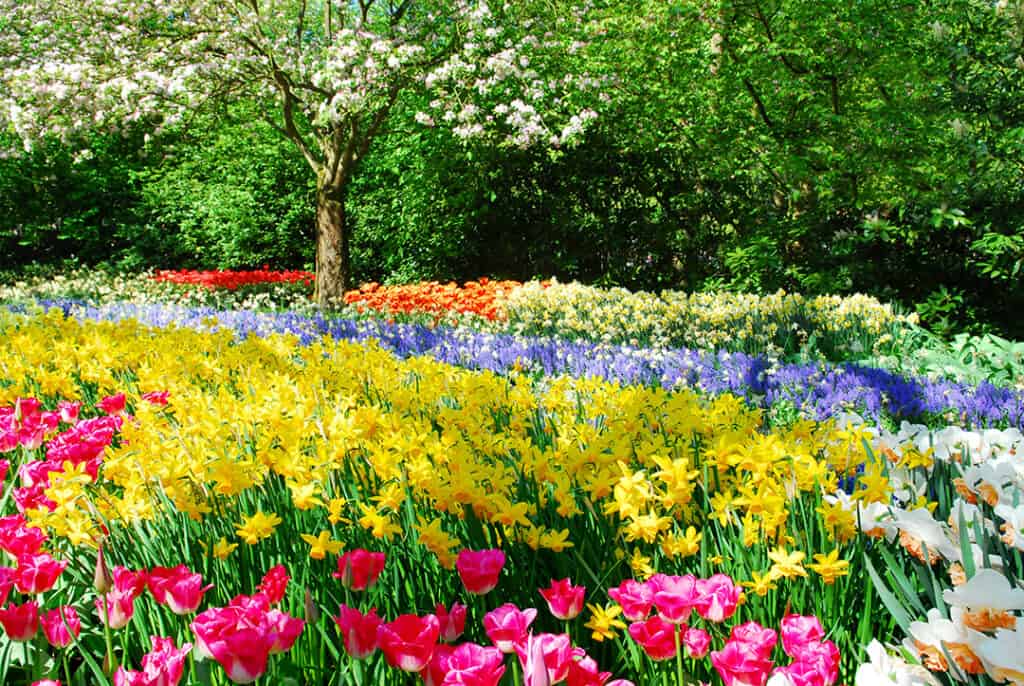Perennial Gardens Brighten The Early Spring Scene
In flower gardens and landscapes, spring begins with bulbs. Here on the East End some of the earliest — and most welcome — color in our landscapes and gardens comes from bulbs. Their bright, warm colors bursting forth after the long cold winter — are balm for the spirit, showing us that spring is coming at last.
These bulbs are planted in fall, but in spring when they’re blooming is the time to think about where to plant more for next spring’s display.

Bulbs are wonderful planted in masses where their early color delights the eye after a too-long winter of bare branches and short, gray days. Clumps of bulbs along a sidewalk, in the front of a foundation bed, or scattered through a perennial garden will brighten the early spring scene. Imagine the glorious sight of a mass of golden daffodils or brilliant red tulips when the trees are just sending out their first new leaves.
For a little work to plant them in fall, bulbs give you a big reward in spring.
The earliest bulbs to bloom are snowdrops and species forms of crocuses, which pole through the ground in March or even February, depending on the weather. These earliest bloomers flower mostly in yellow, white and purple. In fact, yellow and white are much in evidence in spring, as crocuses are followed by the flowers of daffodils and narcissus. Dutch hybrid crocuses – the most familiar kind — have chalice-shaped flowers in shades of deep purple, yellow, yellow-orange and white. The plants grow 4 to 6 inches tall and they’re the first flowers to bloom in many East End gardens.
Daffodils and narcissus are delightful in beds and borders. Plant them (in fall) wherever you’ll be sure to see their welcome flowers in spring. And a big plus for so many East End flower gardeners – deer don’t eat them. There are various types of narcissus
and daffodils, all of which have a central “cup” surrounded by a ring of outer petals, but there are several basic types, and many variations within them. Trumpet narcissus, which we call daffodils, have flowers with a central cup, or trumpet, surrounded by a ring of flat petals. The flowers may be all yellow, all white, bicolored, or may have a yellow or orange trumpet and white outer petals. They may have yellow outer petals and an orange, yellow or salmon-pink cup. In small-cupped narcissus flowers the cup is smaller and shorter than the length of the petals. There are also double-flowered varieties with twice the number of petals.
The other big player among spring bulbs is tulips, the queen of many spring flower gardens. There are thousands of tulip varieties available today. A tremendous selection of heights, colors and blooming times is available, as well as several different flower forms. Tulips bloom in many warm colors, in shades of yellow from soft cream to rich gold, salmon, orange, peach, red, light and dark pink, pale to deep rose, purples and even a dramatic deep maroon-black one called Queen of the Night. There are bicolored tulips striped or feathered or flamed with a second color. There are tulips in soft pastel shades, vibrant jewel tones and dramatic bi-colors. Some have fringed, curled or twisted petals.
If you don’t have deer issues on your property, you can choose tulips for your garden that harmonize or contrast, whose colors whisper softly in the landscape or make a bold, dramatic statement. They can range in height from 8 inches to 2 feet or more.
If you can keep the deer off your premises, with high perimeter fencing and tall, sturdy gates, plantings of graceful tulips can be a symphony of color in spring. Mass them in beds and borders, or buy pots of tulips when you see them in the garden center and group them on your deck or porch. When the show is over, toss them. Many tulips have to be treated like annuals and planted anew anyway. But they are undeniably wonderful, as is the most welcome return of springtime.












![Welcome to Le Beau Chateau, a grand French-style manor house originally built in 1937 on a 52± acre property restored and reimagined to perfection. Boasting pedigree, provenance and stunning design, 104 Dans highway has been magically transformed with a seamless infusion of bespoke finishes, quiet luxury and comfort. Represented by Rob Johnson of @brownharrisstevens. [link in bio]](https://hamptonsrealestateshowcase.com/wp-content/uploads/sb-instagram-feed-images/470917491_18481320940030135_2744230950629794022_nfull.webp)
![Located south of the highway on a quiet street, this airy and fresh, newly built 7 bedroom, 7.5 bath home exemplifies superb design with clean lines on all three levels. Bright and airy, with an open floor plan and walls of sliding glass doors overlooking the backyard and pool, this house is designed for today’s lifestyle. Represented by @sharonsternhomes of @sothebysrealty. [link in bio]](https://hamptonsrealestateshowcase.com/wp-content/uploads/sb-instagram-feed-images/470870424_18481119913030135_1232666844537840589_nfull.webp)
![This stunning waterfront home in Quogue offers direct access to Shinnecock Bay via a private boardwalk. 36 Second Neck Lane features expansive outdoor living spaces with a full kitchen, BBQ, pizza oven, and bar, plus a heated saltwater infinity pool and oversized hot tub. Represented by Nick Messina of @douglaselliman. [link in bio]](https://hamptonsrealestateshowcase.com/wp-content/uploads/sb-instagram-feed-images/470669759_18480889417030135_2117744731444738551_nfull.webp)
![Conveniently located in Water Mill, this turnkey one-level contemporary is sited at the end of a winding driveway on 1.60± private acres. The expansive, move-in ready residence has undergone a complete remodel and features 4 bedrooms and 3 bathrooms across 2,630± sq. ft. of living space. Represented by Craig Beem of @brownharrisstevens. [link in bio]](https://hamptonsrealestateshowcase.com/wp-content/uploads/sb-instagram-feed-images/470491935_18480720649030135_1941783907149758766_nfull.webp)
![Is there anything more magical than the holidays in the Hamptons? Maybe stress-free hosts who can actually enjoy them! To help you skip the last-minute scramble, we turned to expert Kathy Kuo for her top tips on getting your home holiday-ready 🎄🥂 [link in bio]](https://hamptonsrealestateshowcase.com/wp-content/uploads/sb-instagram-feed-images/470324287_553988460734287_2505109464299263530_nfull.webp)
![Cheers to holiday hosting! 🍸✨ Create the perfect at-home bar to keep the good times flowing all season long. From festive cocktails to cozy vibes, let your space shine as the ultimate gathering spot. [link in bio]](https://hamptonsrealestateshowcase.com/wp-content/uploads/sb-instagram-feed-images/470165157_1642639376465060_2596893328383899816_nfull.webp)
![A partially built 19,980± sq. ft. mansion on one of the Hamptons’ most prestigious streets, left abandoned since 2018, has finally found a buyer! The sprawling property — the largest oceanfront parcel on Meadow Lane, features arched windows and doorways, a flat roof with pyramids and conical peaks, plus a sandstone facade. Co-listed with @bespoke.realestate and @hamptonsluxurymarketleader of @thecorcorangroup. [link in bio]](https://hamptonsrealestateshowcase.com/wp-content/uploads/sb-instagram-feed-images/469724902_18479864281030135_7735465365115439625_nfull.webp)
